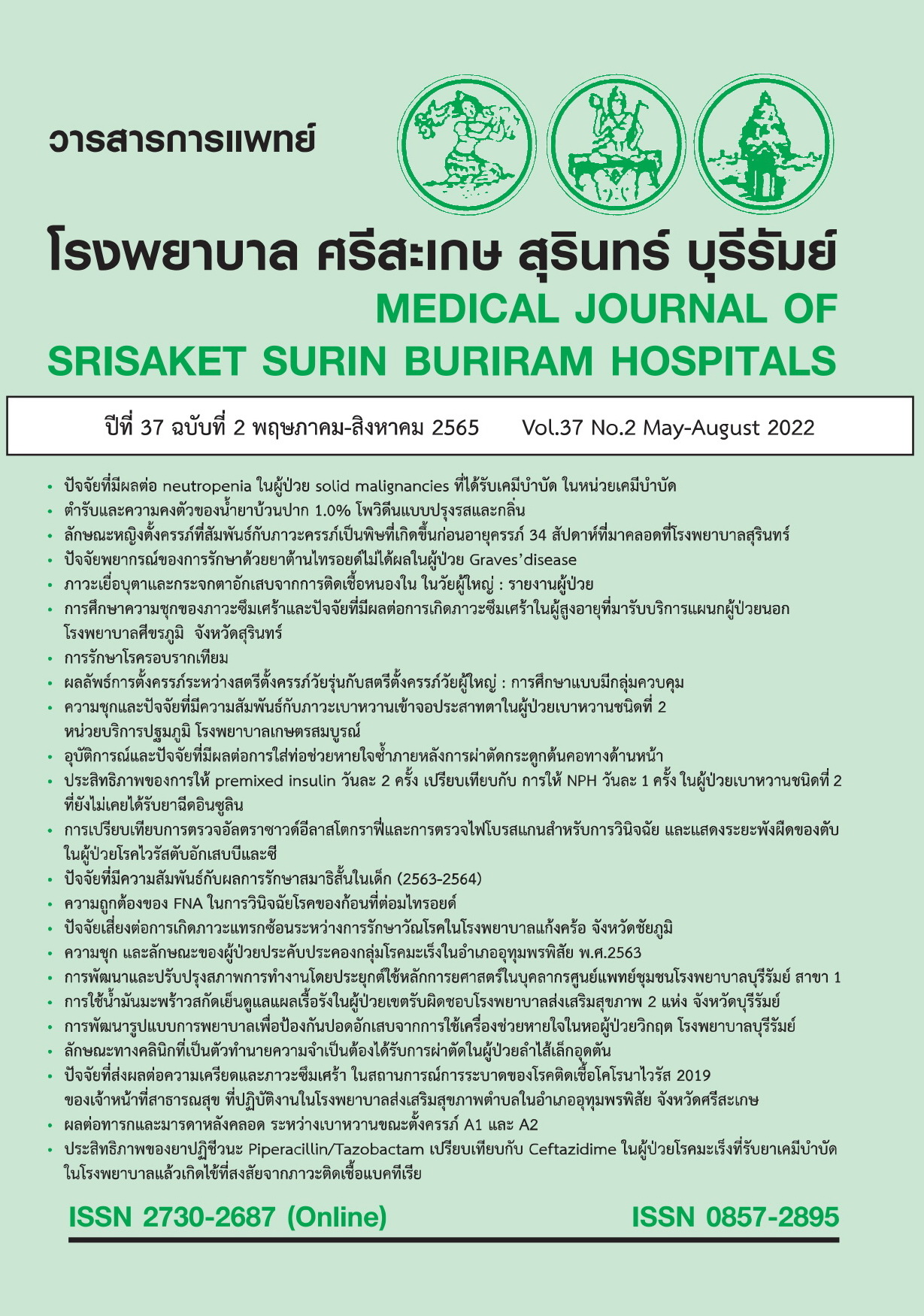ปัจจัยเสี่ยงต่อการเกิดภาวะแทรกซ้อนระหว่างการรักษาวัณโรคในโรงพยาบาลแก้งคร้อ จังหวัดชัยภูมิ
Main Article Content
บทคัดย่อ
หลักการและเหตุผล: สถานการณ์วัณโรคของโรงพยาบาลแก้งคร้อ จังหวัดชัยภูมิ ระหว่าง 1 ตุลาคม พ.ศ.2559 ถึง 30 กันยายน พ.ศ.2564 พบผู้ป่วยวัณโรคจำนวน 432 ราย เกิดภาวะแทรกซ้อนระหว่างรักษา 72 ราย หรือร้อยละ 16 การศึกษานี้จะค้นหาและวิเคราะห์ปัจจัยเสี่ยงต่อการเกิดภาวะแทรกซ้อนระหว่างการรักษาวัณโรคในโรงพยาบาลแก้งคร้อ
วิธีการศึกษา: ศึกษาแบบ descriptive retrospective study เก็บข้อมูลผู้ป่วยวัณโรคอายุมากกว่า 15 ปี ระหว่าง 1 ตุลาคม พ.ศ.2559 ถึง 30 กันยายน พ.ศ.2564 จำนวน 432 ราย จากฐานข้อมูลโรงพยาบาลและ National tuberculosis information program
ผลการศึกษา: ภาวะแทรกซ้อนที่สนใจ คือ ผื่นผิวหนังผิดปกติ ตับอักเสบ ภาวะน้ำดีคั่ง เก๊าท์อักเสบเฉียบพลัน ภาวะการทรงตัวผิดปกติ และจอประสาทตาอักเสบ ผลการศึกษาพบว่าปัจจัยที่ส่งผลต่อการเกิดภาวะแทรกซ้อนอย่างมีนัยสำคัญ คือ โรคเบาหวาน crude OR 2.06 (1.21-3.51) การติดเชื้อไวรัสตับอักเสบบี crude OR 9.59 (2.73-33.68) การติดเชื้อไวรัสตับอักเสบซี crude OR 6.64 (1.74-25.38) การติดเชื้อไวรัสเอชไอวี crude OR 2.74 (1.23-6.14) และโรคเก๊าท์ Crude OR 3.55 (1.22-10.29)
สรุป: ปัจจัยที่ส่งผลต่อการเกิดภาวะแทรกซ้อนระหว่างการรักษาวัณโรคในโรงพยาบาลแก้งคร้อ คือ โรคเบาหวาน การติดเชื้อไวรัสตับอักเสบบีและซี การติดเชื้อไวรัสเอชไอวีและโรคเก๊าท์
Article Details

This work is licensed under a Creative Commons Attribution-NonCommercial-NoDerivatives 4.0 International License.
References
World Health Organization. Global tuberculosis report 2021. [Internet]. [Cited 2022 March 2]. Available from:URL:https://www.who.int/publications/i/item/9789240037021
Cusack RP, Chawke L, O'Brien DJ, O'Connor B, O'Connor TM. Predictors of hepatotoxicity among patients treated with antituberculous medication. QJM 2017;110(4):219-25. doi: 10.1093/qjmed/hcw160.
Yee D, Valiquette C, Pelletier M, Parisien I, Rocher I, Menzies D. Incidence of serious side effects from first-line antituberculosis drugs among patients treated for active tuberculosis. Am J Respir Crit Care Med 2003;167(11):1472-7. doi: 10.1164/rccm.200206-626OC.
Saukkonen JJ, Cohn DL, Jasmer RM, Schenker S, Jereb JA, Nolan CM, et al. An official ATS statement: hepatotoxicity of antituberculosis therapy. Am J Respir Crit Care Med 2006;174(8):935-52. doi: 10.1164/rccm.200510-1666ST.
No authors listed. A controlled clinical trial of 3- and 5-month regimens in the treatment of sputum-positive pulmonary tuberculosis in South India. Tuberculosis Research Centre, Madras, and National Tuberculosis Institute, Bangalore. Am Rev Respir Dis 1986;134(1):27-33. doi: 10.1164/arrd.1986.134.1.27.
Kwon BS, Kim Y, Lee SH, Lim SY, Lee YJ, Park JS, et al. The high incidence of severe adverse events due to pyrazinamide in elderly patients with tuberculosis. PLoS One 2020;15(7):e0236109. doi: 10.1371/journal.pone.0236109.
Ahmed M, Mishra A, Sawlani KK, Verma V, Garg R, Singh HP, et al. Clinical Predictors of Streptomycin-Vestibulotoxicity. Indian J Otolaryngol Head Neck Surg 2016;68(3):359-66. doi: 10.1007/s12070-015-0949-x.
Chamberlain PD, Sadaka A, Berry S, Lee AG.Ethambutol optic neuropathy. Curr Opin Ophthalmol 2017;28(6):545-51. doi: 10.1097/ICU.0000000000000416.
Resende LS, Santos-Neto ET. Risk factors associated with adverse reactions to antituberculosis drugs. J Bras Pneumol 2015;41(1):77-89. doi: 10.1590/S1806-37132015000100010.
Chung-Delgado K, Revilla-Montag A, Guillen-Bravo S, Velez-Segovia E, Soria-Montoya A, Nuñez-Garbin A, et al. Factors associated with anti-tuberculosis medication adverse effects: a case-control study in Lima, Peru. PLoS One 2011;6(11):e27610. doi: 10.1371/journal.pone.0027610.
Han XQ, Pang Y, Ma Y, Liu YH, Guo R, Shu W, et al. Prevalence and Risk Factors Associated with Adverse Drug Reactions among Previously Treated Tuberculosis Patients in China. Biomed Environ Sci 2017;30(2):139-42. doi: 10.3967/bes2017.018.
Castro AT, Mendes M, Freitas S, Roxo PC. Incidence and risk factors of major toxicity associated to first-line antituberculosis drugs for latent and active tuberculosis during a period of 10 years.
Rev Port Pneumol (2006) 2015;21(3):144-50. doi: 10.1016/j.rppnen.2014.08.004.
Kwan CK, Ernst JD. HIV and tuberculosis: a deadly human syndemic. Clin Microbiol Rev 2011;24(2):351-76. doi: 10.1128/CMR.00042-10.
Lomtadze N, Kupreishvili L, Salakaia A, Vashakidze S, Sharvadze L, Kempker RR, et al. Hepatitis C virus co-infection increases the risk of anti-tuberculosis drug-induced hepatotoxicity among patients with pulmonary tuberculosis. PLoS One 2013;8(12):e83892. doi: 10.1371/journal.pone.0083892.
Ray S, Talukdar A, Kundu S, Khanra D, Sonthalia N. Diagnosis and management of miliary tuberculosis: current state and future perspectives. Ther Clin Risk Manag 2013;9:9-26. https://doi.org/10.2147/TCRM.S29179
Siddiqui AN, Khayyam KU, Sharma M. Effect of Diabetes Mellitus on Tuberculosis Treatment Outcome and Adverse Reactions in Patients Receiving Directly Observed Treatment Strategy in India: A Prospective Study. Biomed Res Int 2016;2016:7273935. doi: 10.1155/2016/7273935.
Yorke E, Atiase Y, Akpalu J, Sarfo-Kantanka O, Boima V, Dey ID. The Bidirectional Relationship between Tuberculosis and Diabetes. Tuberc Res Treat 2017;2017:1702578. doi: 10.1155/2017/1702578.
Schutz C, Meintjes G, Almajid F, Wilkinson RJ, Pozniak A. Clinical management of tuberculosis and HIV-1 co-infection. Eur Respir J 2010;36(6):1460-81. doi: 10.1183/09031936.00110210
Sirinak C, Kittikraisak W, Pinjeesekikul D, Charusuntonsri P, Luanloed P, Srisuwanvilai LO, et al. Viral hepatitis and HIV-associated tuberculosis: risk factors and TB treatment outcomes in Thailand. BMC Public Health 2008;8:245. doi: 10.1186/1471-2458-8-245.
Singh JA, Reddy SG, Kundukulam J. Risk factors for gout and prevention: a systematic review of the literature. Curr Opin Rheumatol 2011;23(2):192-202. doi: 10.1097/BOR.0b013e3283438e13.
Afzali A, Weiss NS, Boyko EJ, Ioannou GN. Association between serum uric acid level and chronic liver disease in the United States. Hepatology 2010;52(2):578-89. doi: 10.1002/hep.23717.
Zheng J, Guo MH, Peng HW, Cai XL, Wu YL, Peng XE. The role of hepatitis B infection in anti-tuberculosis drug-induced liver injury: a meta-analysis of cohort studies. Epidemiol Infect 2020;148:e290. doi: 10.1017/S0950268820002861.

